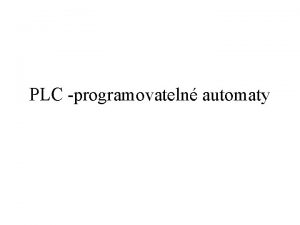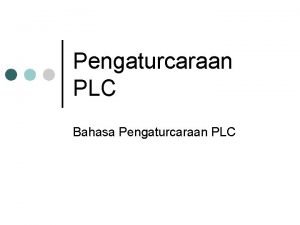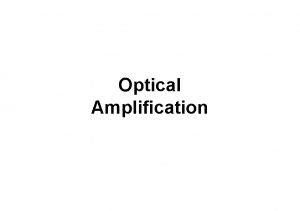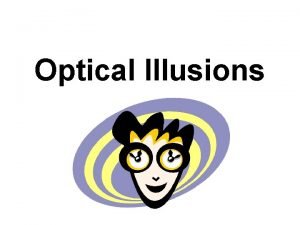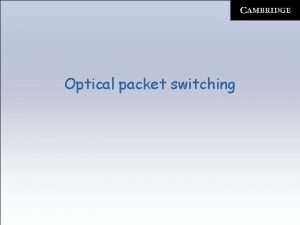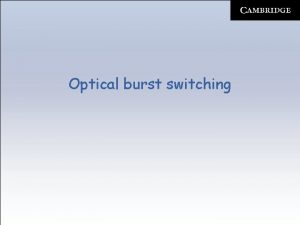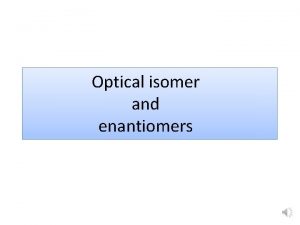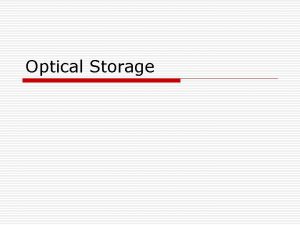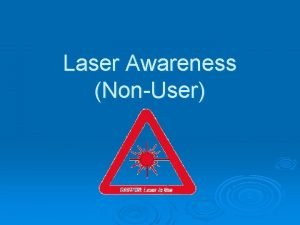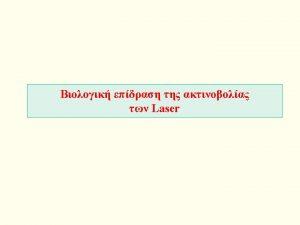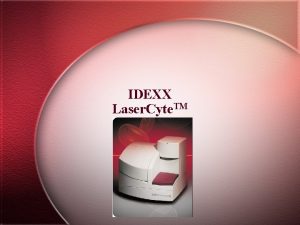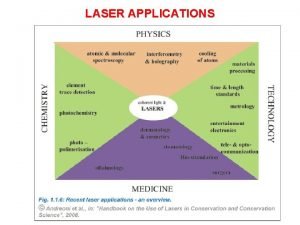Laser source for PLC Optical RD for Laser



























- Slides: 27

Laser source for PLC Optical R&D for Laser beam - electron beam Compton scattering Technology 1. Laser Request for PLC 2. Technical solutions Non linear cavity Fabry-Perot optical resonator 3. R&D of optical cavities F. Zomer, 25, march, 2011 1

Laser beam requested for PLC Such a laser beam does not exist one has to use specific solutions 2

1 rst class of technical solution to reach high laser average power: Nonlinear circulating cavity & Regenerative cavity Principle 3

Regenerative cavity Sprangle et al. JAP 72(1992)5032 Thermal issues in the pumped gain medium Non linear cavity (LLNL) Jovanovic et al. , NIMA 578(2007)160 Frequency doubling cristal allowing high fluence Non-linear effects issue 4

2 nd technical solution to reach high laser average power: Fabry-Perot cavity Principle 5

Fabry-Perot cavity: Principle with continous wave e beam Gain=1/(1 -R) 10000 ~10 k. W ~1 W LASER isolateur ~1 W JLAB/Saclay Polarimeter, NIMA 459(2001)412 HERA /Orsay Polarimeter, JINST 5(2010)P 06005 When n. Laser c/2 L • But: Dn/n. Laser = 10 -11 feedback needed… résonance STRONG & ROBUST laser/cavity 6

Fabry-Perot cavity in pulsed regime Electron beam 1 ps Mode lock oscillator Fabry-Perot cavity with Super mirrors Same feedback technics (more complexe) is used in cw & pulsed regime State of the art (Garching MPI) : ~70 k. W, 2 ps pulses @78 MHz, stored in a cavity (O. L. 35(2010)2052) ~20 k. W, 200 fs pulses @78 MHz 7

Technical design study for PLC 8

Cavity ‘gain’ ~100 -500 50 m. J/pulse 9

Technological issues üIncident laser seems deliverable (J Gronberg ILWC 2010) üDamage thresholds of the mirror/optics coatings üAverage power thermal load üSeems ok for 70 k. W @1 ps üPeack power damage ? üHuge mechanical structure (~15 m!) mechanical stability ? üFrequency and spatial quality of the incident laser beam ? üPolarisation of the cavity eigen modes ? üLaser beam/cavity feedback @ 5 Hz ? (@~100 MHz usually !) ILWC 2010 Geneva Switzerland 10

Illustration of one issue : the laser cavity feedback Cavity finesse : F=(100 -500) p Optical path length : L~100 m Cavity resonance frequency linewidth Dn=c/(LF)~(2 -9) k. Hz ! Dn/n=l/(LF)=~10 -11 -10 -12 Same numbers as in metrology !!! M. Oxborrow 11

From a feedback point of view: Locking a ‘ 100 m’ cavity to finesse~ 600 (‘gain’~2000) is the same as Locking 0. 2 m cavity to 300000 finesse ! BUT The hyper stable small cavity is ‘hyper’ temperature stabilised Into an hyper isolated room In the case of PLC ØHuge laser beam peak power Ølarge frequency/amplitude noise Øbad beam profile quality ØTrains@5 Hz pulse structure ØGiant cavity geometry ØUneasy isolation from noisy accelerator environment Put on an hyper stabilised optical table And an hyper stable cw laser is used, linewidth 1 k. Hz R&D requied http: //www. innolight. de/index. php? id=mephisto ~100 m. W power M. Oxborrow 12

Four-mirror Fabry-Perot cavity R&D at ATF R&D context Starting point : ILC polarised positron source (2005): Ø >10 MW cavity average power needed for ILC/CLIC Now : fundings for compact X-ray sources projects ØQuantum beam/Japan; Thom. X/France Ø 100 k. W-1 MW average power needed 13

The compact Cavité optique Compton X-ray machine (museum , medical applications) ~50 Me. V electrons ring Optical resonator Size ~10 mx 7 m ys X ra Photo gun C S-b LINA ) z H G and (3

French Japanese Collaboration +I. Chaikovska, N. Delerue, R. Marie LAL/France Araki-san 15

2 steps R&D STEP ONE: commissioning a 4 -mirror cavity at ATF, done end 2010 Oscillator (commercial) STEP TWO: upgrade mirrors & laser power =0. 2 W, 1030 nm Dt~0. 2 ps frep=178. 5 MHz ~5 W 100 W Amplifier photonic fiber Yb Doped 2 p 1 t iezos em p. Ctr l. 1 piezo 4 -mirror Fabry-Perot cavity Gain~10000 Numerical feedback ATF clock STEP ONE (done end 2010) With cavity laser/coupling ~50% Power_cavity~2. 5 k. W STEP TWO (with sapphire mirror substrates) With cavity laser/coupling ~50% Power_cavity~250 k. W Final goal: to reach the MW average power ( ~5 m. J/pulse but @178. 5 MHz…) Difference with PLC : ü 5 J/pulse ü ~100 k. W average 16 power

Cavity installation on the Accelerator Test Facility (ATF) at KEK Ba. F 2 calo ~30 Me. V g Cavity 17

Small laser beam size +stable resonator 2 -mirror cavity Stable solution: 4 -mirror cavity as in Femto laser technology BUT elliptical & linearly polarised eigen-modes which are instable because of vibrations at very high finesse Laser input e- beam Non-planar 4 -mirror cavity Stable & circularly polarised eigenmodes (AO 48(2009)6651) as needed for an ILC polarised positron source and PLC 18

Non planar 4 -mirror compact cavity design for an accelerator ( ATF) 2 spherical mirrors ATF beam pipe: 5 mm slit… Angle laser / e- beam= 8° ATF e laser/beam Interaction point - beam m Injection laser ~50 c 2 flat mirrors 19

Mirror positioning system 2 spherical mirrors 12 encapsulated Motors e- Vacuum inside ~3 x 10 -8 mbar without baking (in situ) laser 2 flat mirrors Invar base to ensure length stability 20

Class 100 air flow Electron beam pipe ATF table mount system (~1µm precision) used for spatial laser and ebeam matching Assumed ATF Beam Line KEK 2 -mirror cavity Implementation at ATF Pulse Motor Port for Up-Down Move From Hirotaka-san Pulse Motor Port for Horizontal Move 21

The optical scheme Feedback system Phase modulator needed for the laser/cavity feedback • Signal reflected by the cavity used to build the laser/cavity feedback signal: • interference between the modulated incident laser beam AND the leackage on the beam circulating inside the cavity 22

The laser amplification R&D We use Ytterbium doped photonic cristal fiber as amplifier Ø core = 40 µm Ø cladding = 200 µm Toward cavity laser • We obtained 60 W average power ~stable thanks to connectorisation R&D • 800 W (11µJ/pulse) demonstrated with the same technique Limpert, OL 35(2010)94 Fiber amplifier 23 23

But we broke, burnt many fibres Using 100 W pumping diode (focused on 400µm)… technological R&D to reach long term stability and reliability … additive phase noise also an issue… 24

Laser/cavity numerical feedback development Rétroaction on laser frequency Clk = 100 MHz 8 x ADC 14 bits 8 x DAC 14 bits => Filtering => 18 bits / 400 k. Hz FPGA Virtex II 25

Results before the earth quake One very short run before ATF breakdown (modulator on fire 3 week before the earth quake…) üLaser power ~10 W (we had ~60 W aside) üCavity laser/coupling ~30% (best measured~60%) Power_cavity~3 k. W PM Waveform ~25/g/bunch-Xsing (Emax=28 Me. V)

Summary • The resonant cavity is a technical issue for the PLC laser beam – Same feedback performance as for metrology experiment is required … • Benefit can be taken from R&D on compact Compton X-ray sources – To reach high stack average power with stable laser/cavity locking – To provide stable/stabilised optical resonator design for accelerator environment • Geometry mode polarisation – Robust feedback system • Still, locking a 5 Hz train of ~3000 laser pulses of 50 m. J will remain to be demonstrated … 27
 Shingelfrisyren
Shingelfrisyren Brunn karttecken
Brunn karttecken Mjälthilus
Mjälthilus Multiplikation med uppställning
Multiplikation med uppställning Formel för lufttryck
Formel för lufttryck Elektronik för barn
Elektronik för barn Toppslätskivling dos
Toppslätskivling dos Borra hål för knoppar
Borra hål för knoppar Bris för vuxna
Bris för vuxna Mat för unga idrottare
Mat för unga idrottare A gastrica
A gastrica Smärtskolan kunskap för livet
Smärtskolan kunskap för livet Frgar
Frgar Vad är ett minoritetsspråk
Vad är ett minoritetsspråk Etik och ledarskap etisk kod för chefer
Etik och ledarskap etisk kod för chefer Typiska drag för en novell
Typiska drag för en novell Humanitr
Humanitr Rita perspektiv
Rita perspektiv Mall debattartikel
Mall debattartikel Redogör för vad psykologi är
Redogör för vad psykologi är En lathund för arbete med kontinuitetshantering
En lathund för arbete med kontinuitetshantering Skapa med geometriska former
Skapa med geometriska former Claes martinsson
Claes martinsson Publik sektor
Publik sektor Versrader dikt
Versrader dikt Mantel för kvinnor i antikens rom
Mantel för kvinnor i antikens rom Vilken grundregel finns det för tronföljden i sverige?
Vilken grundregel finns det för tronföljden i sverige? Jätte råtta
Jätte råtta
































